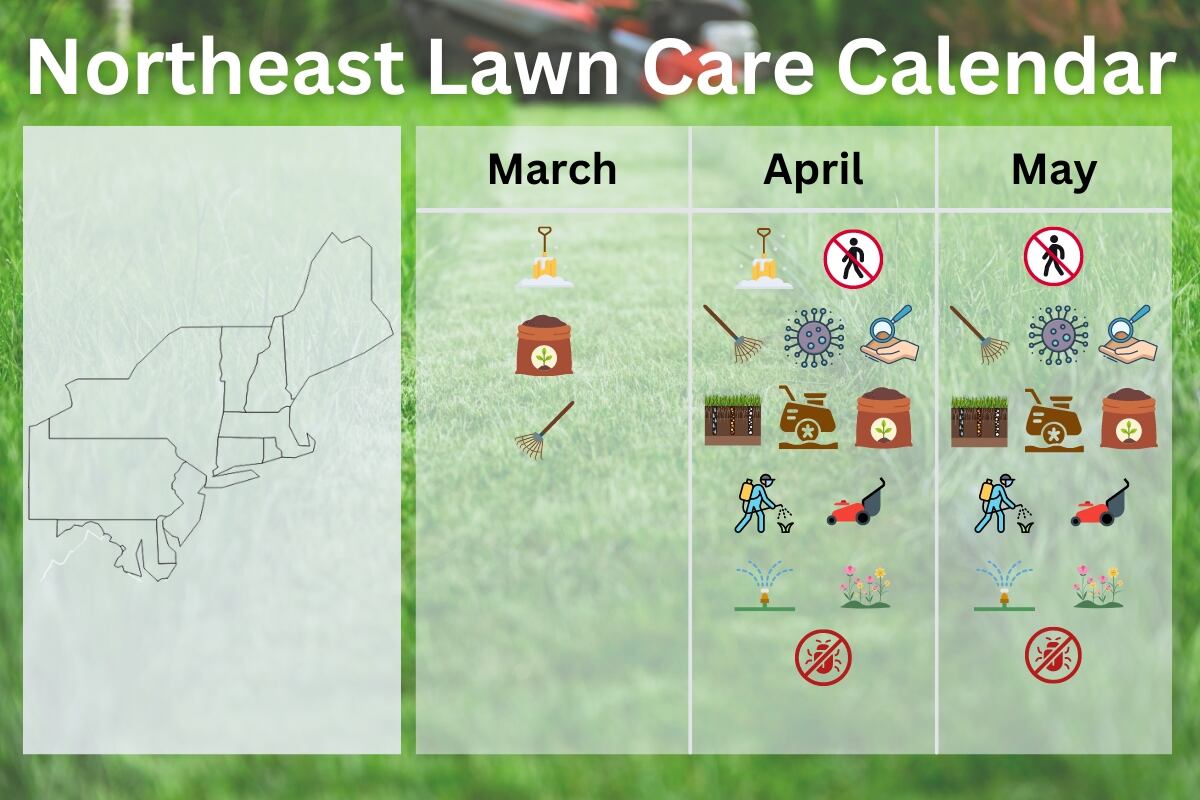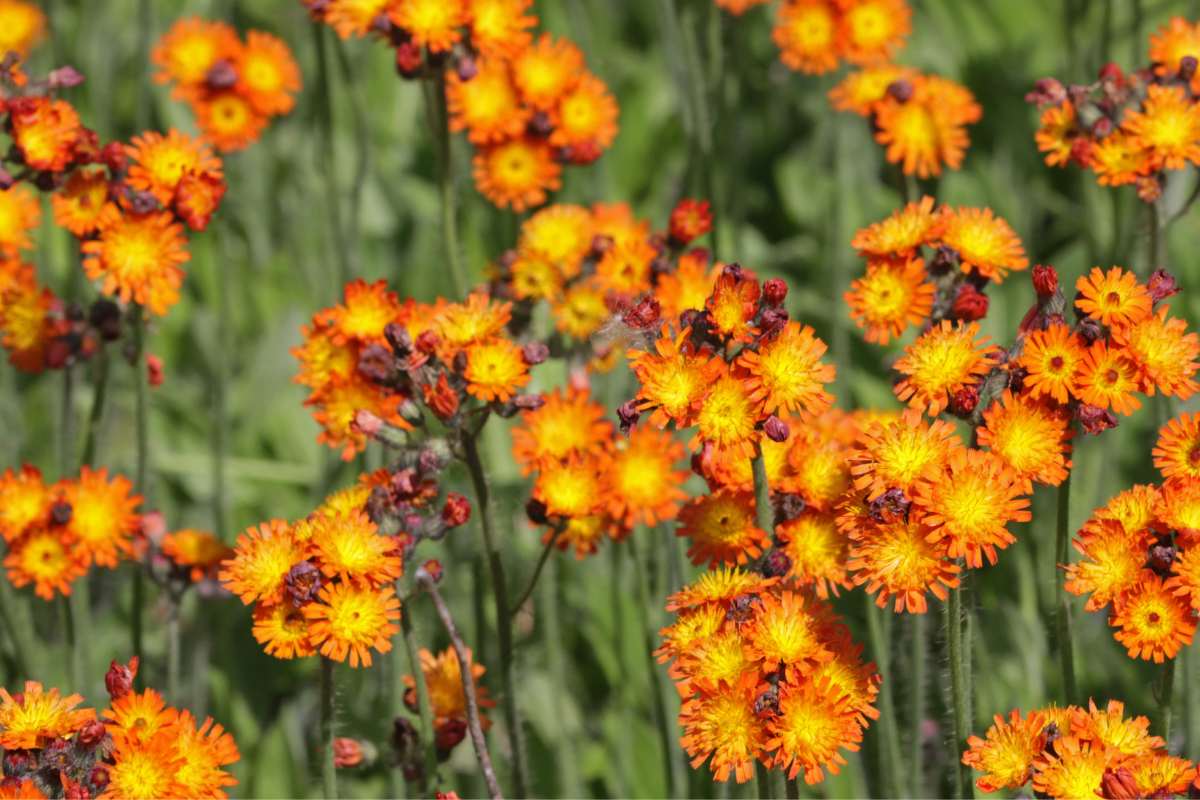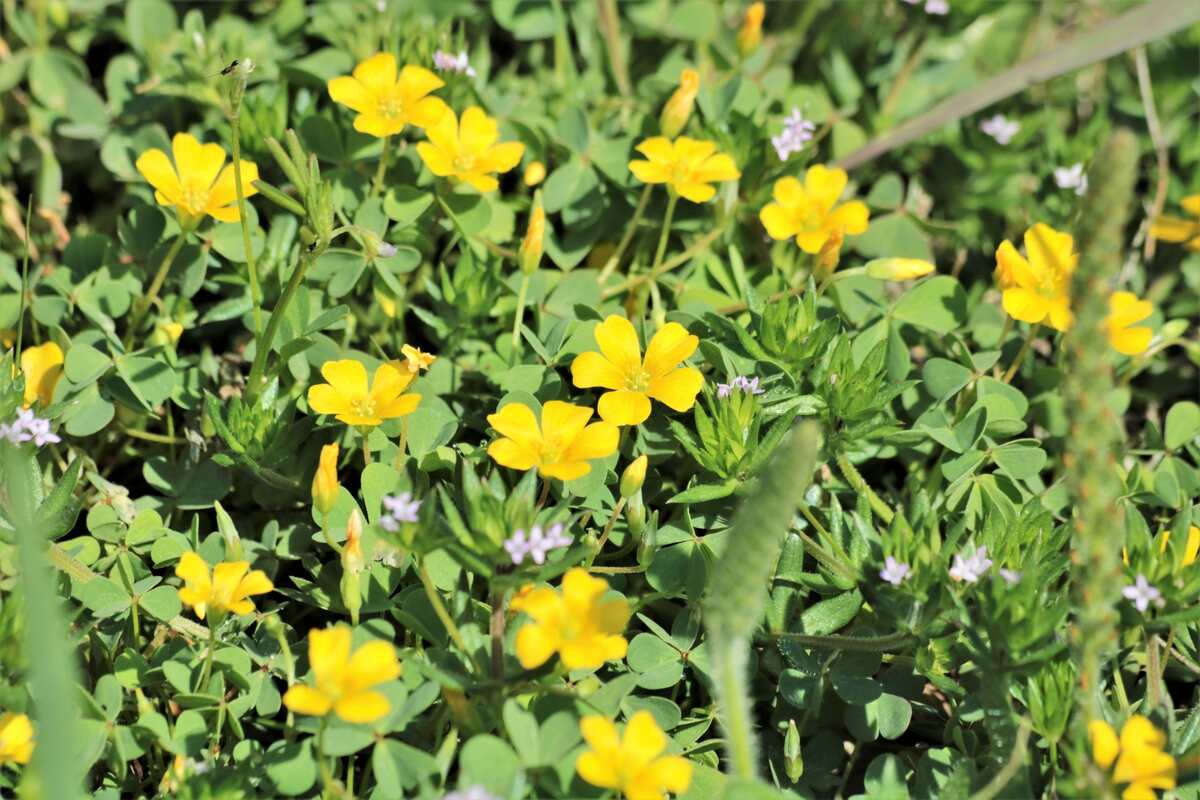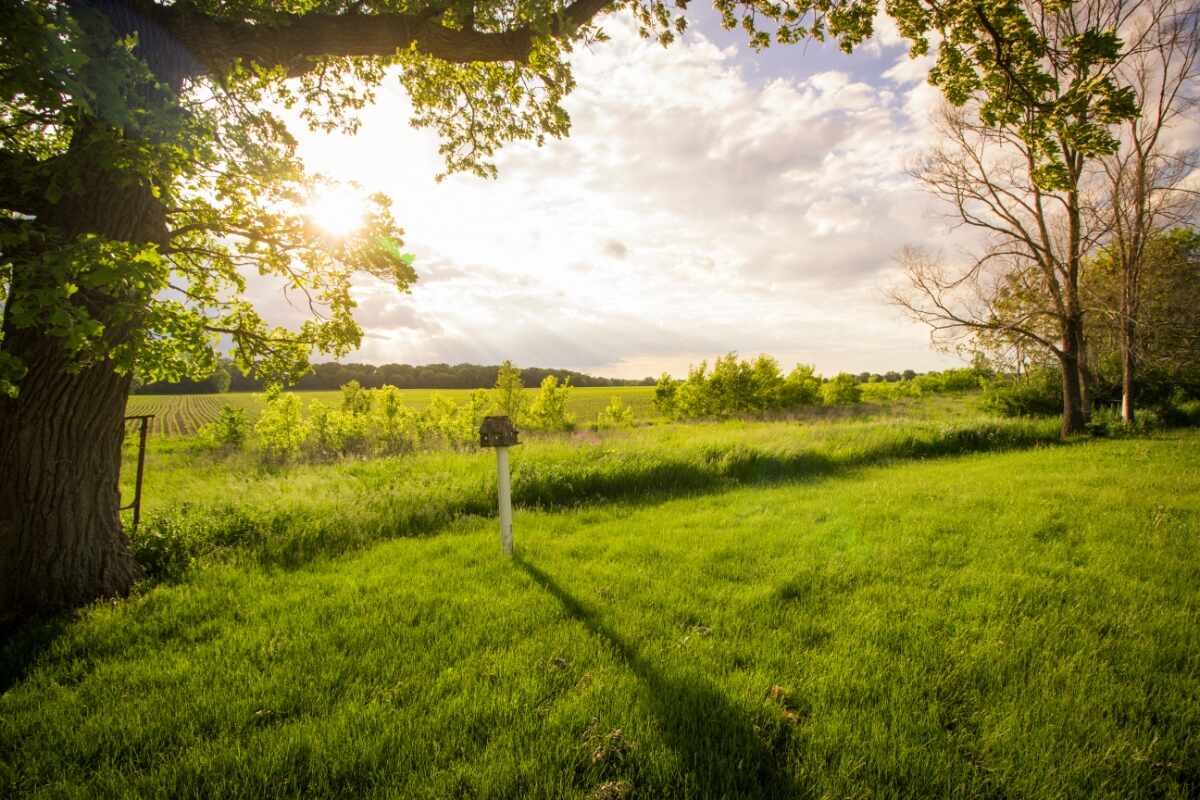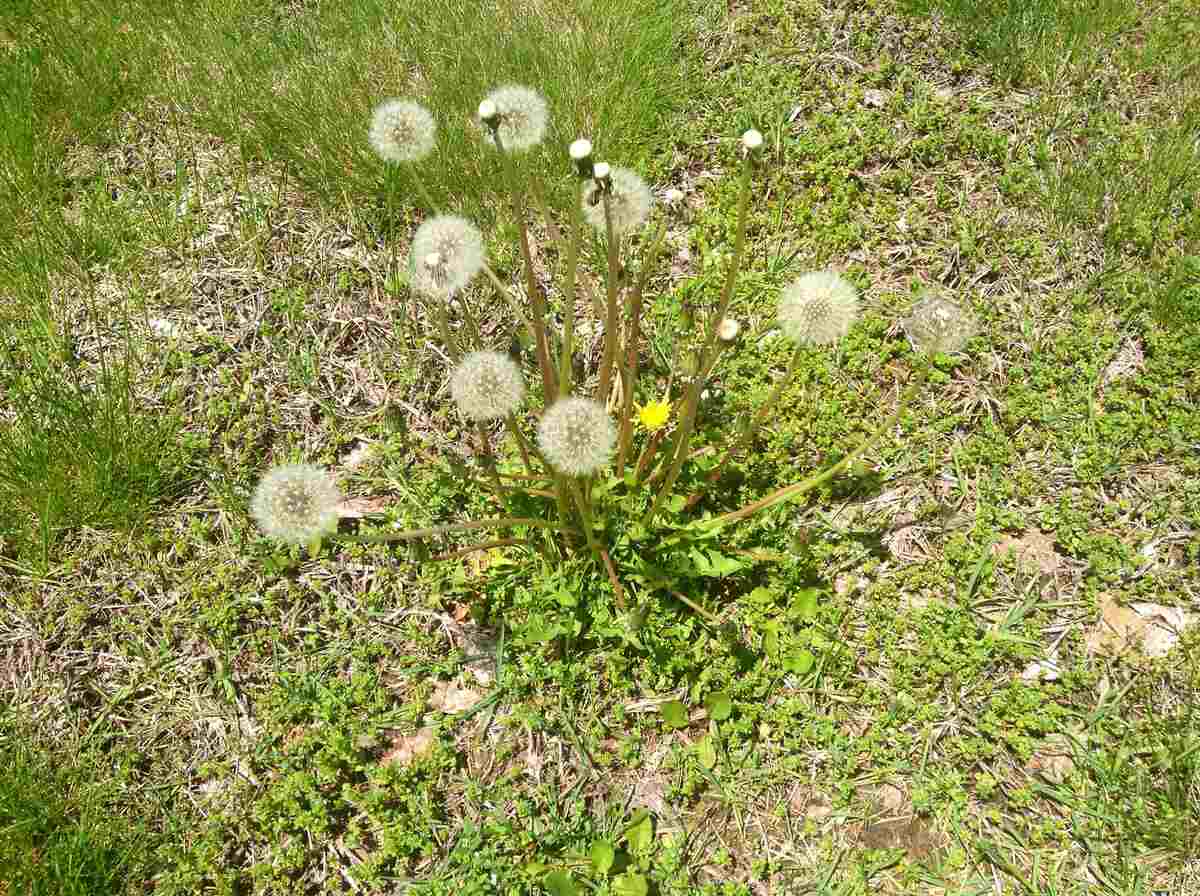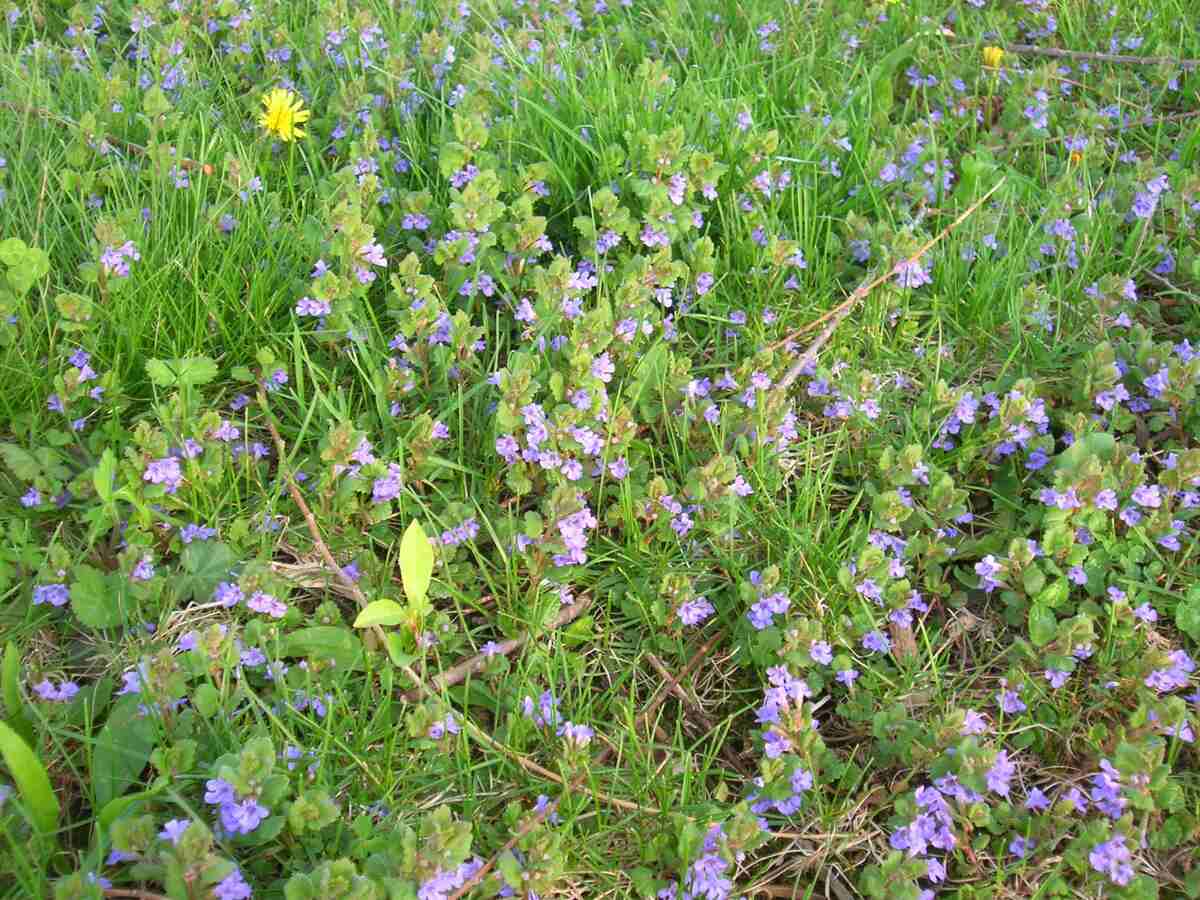
Like most of the Midwest, Ohio has fertile soil — good for agriculture, home gardens, and lawns. But that fertile soil also can nourish a bumper crop of weeds. It can be tough to identify garden and lawn weeds, let alone control them. For help on identification and weed control, see our guide to the 15 most common weeds of Ohio.
- What is a Weed?
- Types of Weeds
- Common Ohio Broadleaf Weeds
- Dandelion (Taraxacum officinale)
- Poison Ivy (Toxicodendron radicans)
- Common Ragweed (Ambrosia artemisiifolia)
- Ground-Ivy (Glechoma hederacea)
- Stinging Nettle (Urtica dioica)
- Yellow Woodsorrel (Oxalis stricta)
- Henbit (Lamium amplexicaule)
- Common Blue Violet (Viola sororia)
- Common Chickweed (Stellaria media (L.) Vill.)
- Japanese Knotweed (Polygonum cuspidatum)
- Common Ohio Shrub Weed
- Common Ohio Grassy Weeds
- FAQ
What is a Weed?
A weed is any plant that grows where it isn’t wanted. Some plants, like poison ivy, definitely aren’t wanted anywhere. But beneficial plants, like mint, can quickly become unwanted if they overtake your vegetable garden or lawn. Generally, a weed:
- Is considered a nuisance.
- Grows quickly.
- Can harm animals and people through contact or ingestion.
- Steals nutrients, sunlight, and water from wanted plants.
Types of Weeds
Weeds can be classified by their looks or their life cycle.
Appearance
Broadleaf. Most have wide leaves with netlike veins. They may have tap roots (think dandelions) or fibrous roots.
Grasses. These are tough to spot early since they look like part of your lawn. They may grow in bunches, have coarser leaves that spread out, or may produce flowers.
Life Cycle
Annual. These weeds grow, flower, and go to seed within a year or less.
Biennials. These complete their growth over two years.
Perennials. These weeds grow for many years. Some spread by seed, others through an extensive root system that makes them hard to eradicate
Here’s a look at 15 common weeds you may find in your Ohio lawn or garden:
Common Ohio Broadleaf Weeds
Dandelion (Taraxacum officinale)
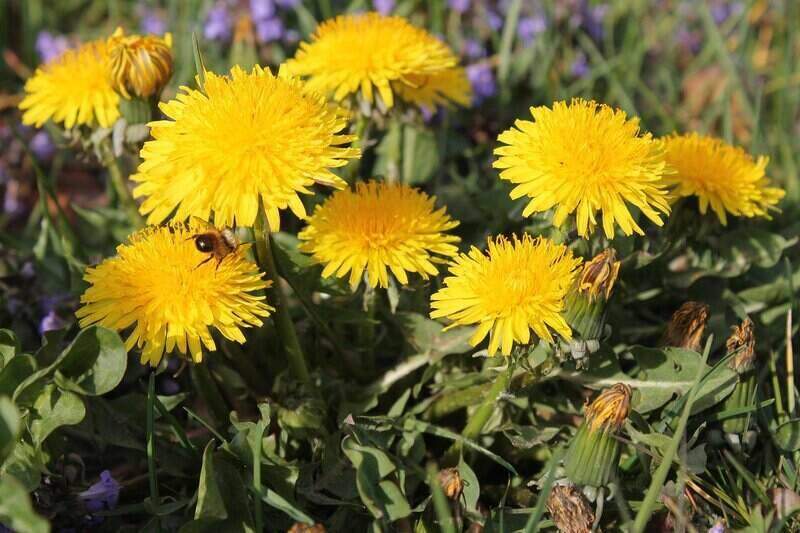
In spring, dandelions pop up in lawns across the U.S. They are tenacious weeds, due in part to their deep taproots. They reproduce by seeds (the white puffballs seen at maturity). However, they also reproduce through remnants of roots left in the soil. If you try to get rid of dandelions by digging, make sure you get all the taproots.
Life cycle: Perennial
Weed type: Broadleaf
Where it thrives: Moist soil and sunlight
How to identify dandelions: A single yellow flower attached to a leafless, hollow stem and jagged basal leaves. At maturity, the flower becomes a white, fluffy seed head.
How to get rid of dandelions: Use a pre-emergent or post-emergent herbicide. Alternatively, dig them up, or snip flowers and heavily mulch the leaves.
Poison Ivy (Toxicodendron radicans)
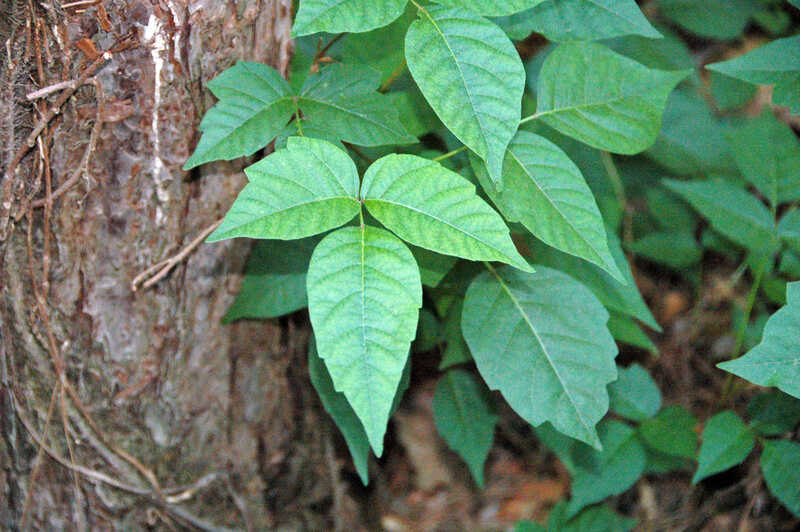
Poison ivy can pop up anywhere, thanks to birds that eat its berries. It grows as a shrub, vine, or ground cover. It propagates through seeds or creeping roots; stems root as they lay on the ground. It’s known for the misery that its oil inflicts on the allergic: a severe, blistering, itchy rash. Wear protective clothing when removing poison ivy from your yard.
Life cycle: Perennial
Weed type: Broadleaf
Where it thrives: Prefers soil with high calcium content.
How to identify poison ivy: Usually identified by its “leaves of three” — alternate leaves consisting of three leaflets. The glossy leaflets may or may not be jagged, and may be elliptical or egg-shaped.
How to get rid of poison ivy: Consider using herbicides with glyphosate or triclopyr. Alternatively, hand pull, or cut. Do not burn: Smoke from poison ivy can cause breathing problems for those sensitive to the toxin.
Common Ragweed (Ambrosia artemisiifolia)
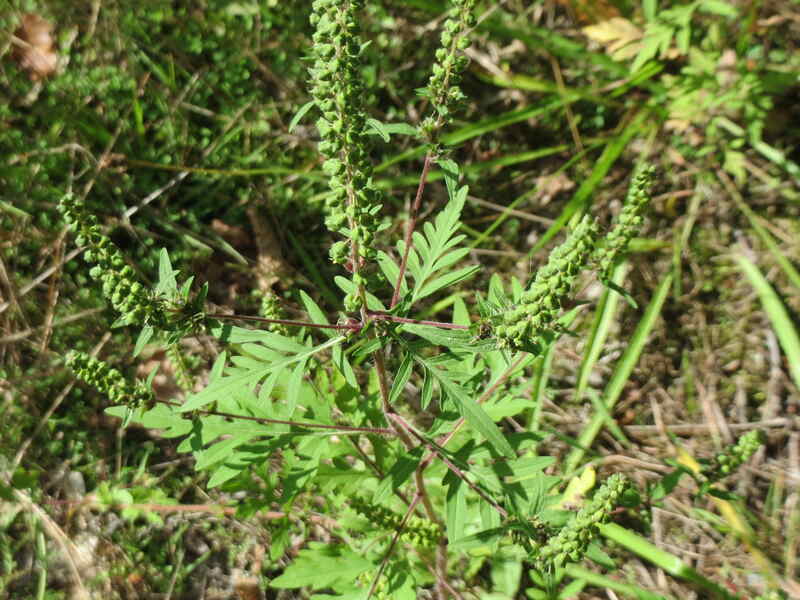
It’s no comfort if you’re allergic to its pollen, but ragweed is a food source for birds, bees, and other insects. Ragweed produces thousands of seeds that can remain viable for years, making it tough to eradicate. It also has properties that can prevent the growth of neighboring plants, making it a serious problem for farmers.
Life cycle: Summer annual
Weed type: Broadleaf
Where it thrives: Grows in any soil, but prefers full sun and slightly dry conditions.
How to identify common ragweed: Grows up to 6 feet tall, with green to purple stems and triangular, hairy leaves.
How to get rid of common ragweed: Use pre- or post-emergent herbicides. (Note: some varieties in Ohio are glyphosate-resistant.) Mowing before the plant flowers is another method of control.
Ground-Ivy (Glechoma hederacea)
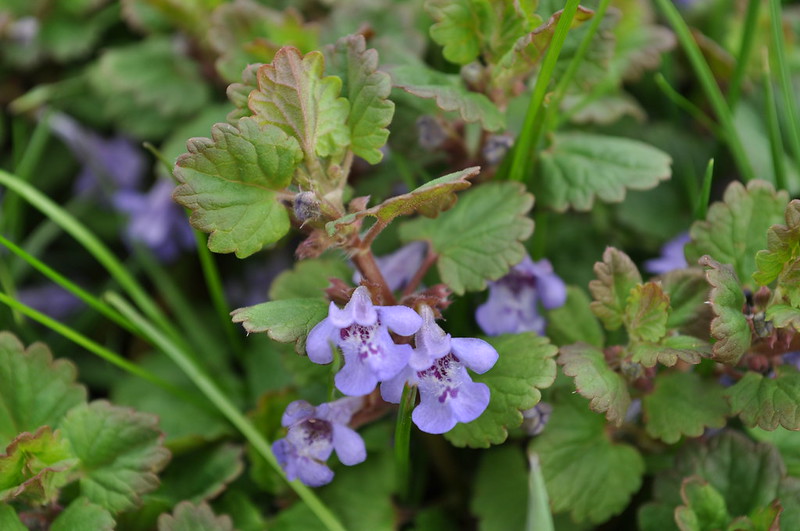
This aggressive weed creeps along the soil, forming a thick mat that crowds out your grass or other plants. (Hence its other name, creeping Charlie.) Ground-ivy does seed but mostly reproduces through its creeping stems, which root in soil. It can be confused with other weeds, like henbit or common mallow.
Life cycle: Perennial
Weed type: Broadleaf
Where it thrives: Prefers shade and moist soils
How to identify ground ivy: This sprawling plant has kidney-shaped leaves with scalloped edges and purplish-blue flowers.
How to get rid of ground ivy: A post-emergent herbicide will kill established plants; pre-emergents have little effect on seeds left in the soil. Pulling it by hand or using a power rake may bring better results.
Stinging Nettle (Urtica dioica)
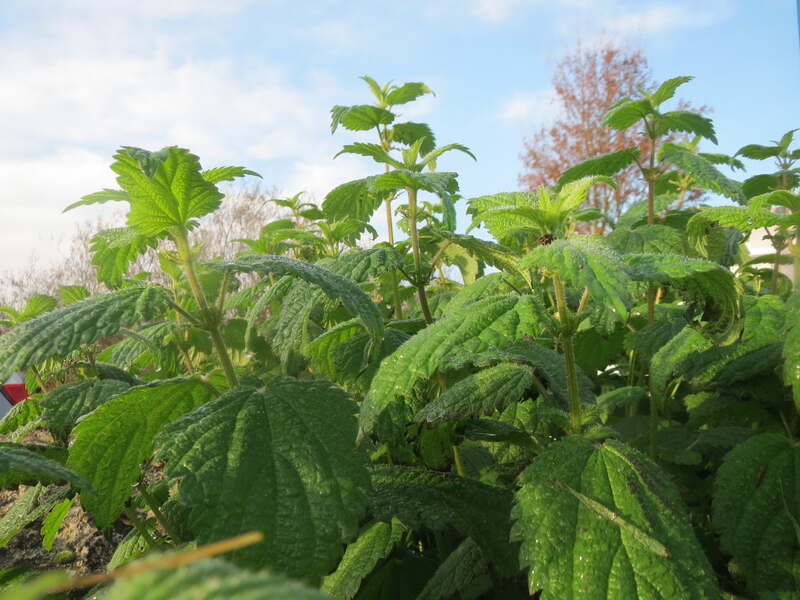
Stinging nettle lives up to its name. Touch it, and tiny hairs on the stem and the underside of its leaves will shoot toxins into your skin (or your pet’s). The result: pain, redness, swelling, and itching. Stinging nettle has a large underground network of stems that allow it to repopulate and spread, making it a difficult weed to control.
Life cycle: Perennial
Weed type: Broadleaf
Where it thrives: Prefers sun and damp, nutrient-rich soil.
How to identify stinging nettle: Grows 3 to 6.5 feet tall, with bright to dark green sawtooth leaves. It produces clusters of tiny, greenish-white flowers.
How to get rid of stinging nettle: One option is to use an herbicide that attacks the root system. (However, some effective herbicides are for professional use only.) Other options include digging or pulling plants. (Use protection and don’t leave plants lying in the yard.) Frequent mowing can thin the colony.
Yellow Woodsorrel (Oxalis stricta)
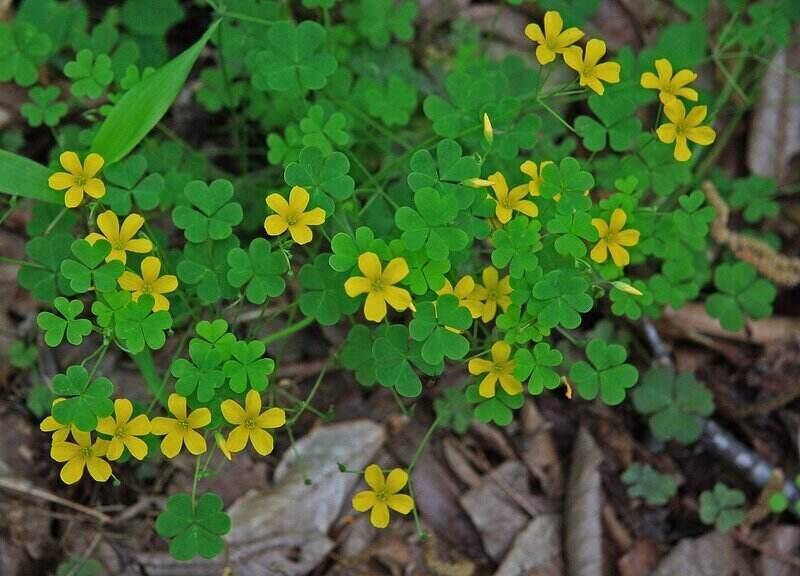
Yellow woodsorrel (also called oxalis) can indicate that your yard has drainage issues. It is a late-germinating weed that may pop up after other broadleaf weeds are dispatched. Like other oxalis plants, it contains soluble oxalate, which, according to the Pet Poison Helpline, can be toxic to dogs and cats if eaten in large quantities.
Life cycle: Perennial
Weed type: Broadleaf
Where it thrives: Prefers full sun and moist soil.
How to identify yellow woodsorrel: This weed looks like clover, with three heart-shaped leaves. However, it produces small yellow flowers with five petals. Check out our article on clover vs. oxalis for more information.
How to get rid of yellow woodsorrel: Herbicides containing triclopyr and fluroxypyr are effective. Young plants can be hand-picked before they flower. A layer of mulch in garden beds will help prevent seed germination.
Henbit (Lamium amplexicaule)
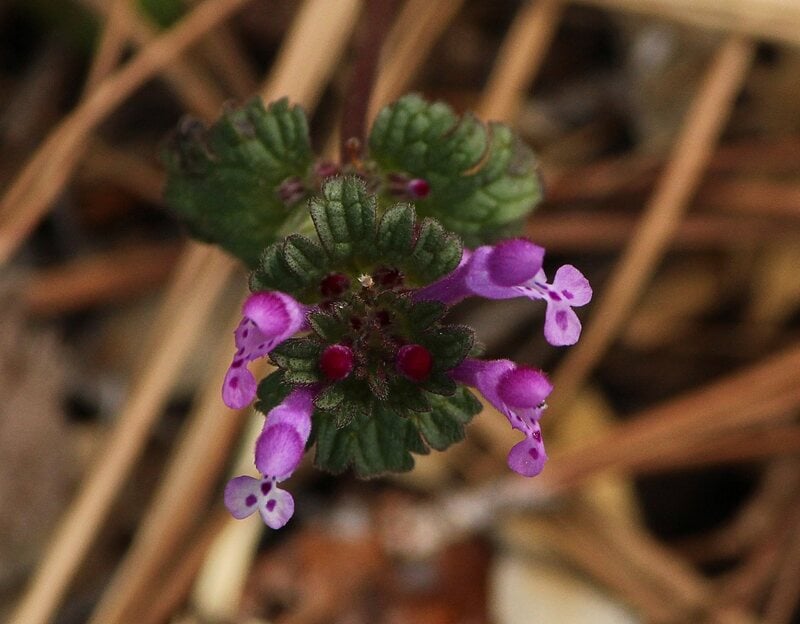
While henbit provides pollen and nectar for bees and hummingbirds, this member of the mint family can quickly invade thin areas of turf. While it tends to be dormant in winter, it can start to grow during any warm period during the season. It is commonly confused with another weed, purple deadnettle.
Life cycle: Winter annual
Weed type: Broadleaf
Where it thrives: Prefers shade and cool, moist areas.
How to identify henbit: Can grow to 16 inches high. Green to purple square stems; egg-shaped leaves with blunt-tooth edges; reddish-purple flowers.
How to get rid of henbit: Proper lawn maintenance is the best preventative: A dense turf will discourage henbit. Post-emergent herbicides work best when plants are seeding or flowering. Plants also can easily be pulled when small.
Common Blue Violet (Viola sororia)

Common blue violet is one of several wild violet species found in the Midwest. The others are wooly blue violet (Viola papilionacea), and confederate violet (Viola sororia f. priceana). While some people welcome the plant as a ground cover, it can spread and compete for resources with turfgrass.
According to the University of Minnesota, common blue violets are edible. The flowers are used in salads or to infuse vinegars or syrups. Novice foragers are advised not to eat the leaves; while they’re edible, they can be confused with non-edible plants. Use caution: Be sure the area has not been treated with herbicides, fertilizers, or pesticides.
Life cycle: Perennial
Weed type: Broadleaf
Where it thrives: Prefers partial sun and most soil.
How to identify common blue violets: Grows about 4 inches high, has heart-shaped leaves with rounded teeth, and produces purple-blue flowers.
How to get rid of common blue violets: If caught early, common blue (or any wild violet) can be hand-pulled. Post-emergent broadleaf herbicides containing Triclopyr should be applied in the fall.
Common Chickweed (Stellaria media (L.) Vill.)
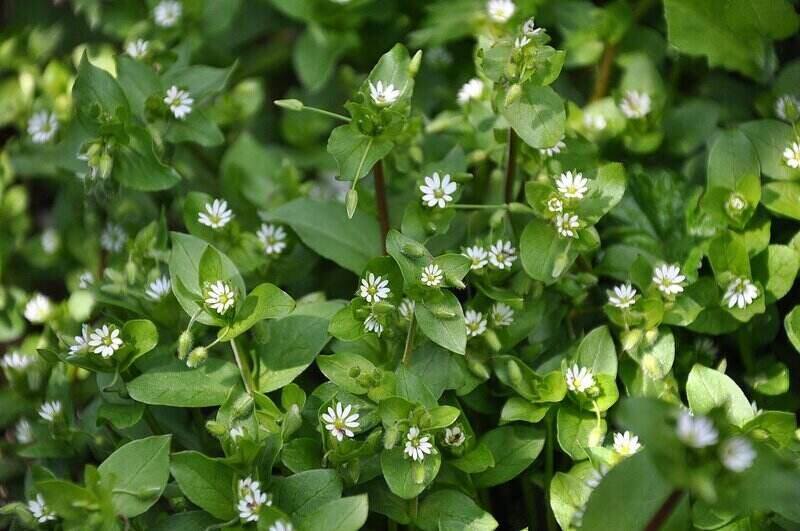
Consider common chickweed to be a stealth weed. Plants produce seeds in spring, then die off. The seeds germinate in the fall, and the plants overwinter then pop up in the spring. Early treatment will help eradicate common chickweed, but plants produce hundreds of seeds, so it may be a years-long process.
Life cycle: Cool season annual
Weed type: Broadleaf
Where it thrives: Full sun or partial shade; moist soil
How to identify common chickweed: Can grow to 4 inches tall. Bright green leaves with pointed tips, and small white flowers with five deeply divided petals.
How to get rid of common chickweed: Pre-emergent herbicides should be applied in late fall; post-emergents are most effective on seedlings. Proper lawn maintenance can help control common chickweed, as can mulching and hand weeding.
Japanese Knotweed (Polygonum cuspidatum)
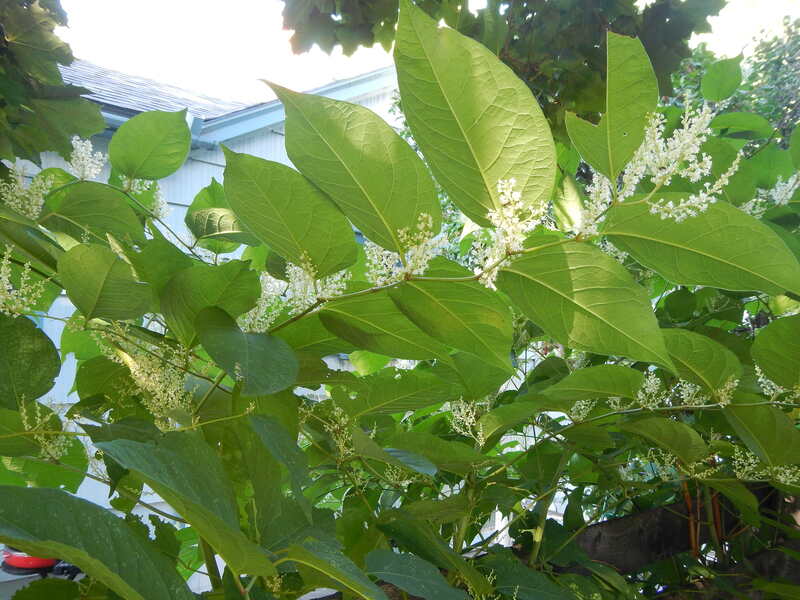
Japanese knotweed has its uses; it attracts bees and stabilizes soil. However, this invasive plant can overrun gardens and yards, crowding out other plants. It can grow through cracks in concrete and damage sidewalks. Japanese knotweed is persistent and hardy, so patience is needed in eradication efforts.
It is considered a noxious weed in some states.
Life cycle: Perennial
Weed type: Broadleaf
Where it thrives: Full sun, though can tolerate shade. Moist soil.
How to identify Japanese Knotweed: Occasionally mistaken for bamboo, Japanese Knotweed can grow to 13 feet. It has oval leaves that are pointed at the tip and produces clusters of whitish-green flowers.
How to get rid of Japanese Knotweed: Due to its massive underground system of rhizomes, knotweed is hard to eradicate. Digging and hand-pulling can leave rhizomes behind to start anew.
Mowing is one option. (If you mow, bag all parts and clean equipment to prevent spread.) Some herbicides do work but can put other plants at risk. Use caution when applying herbicides near a waterway.
Common Ohio Shrub Weed
Bush Honeysuckles (Diervilla ssp.)
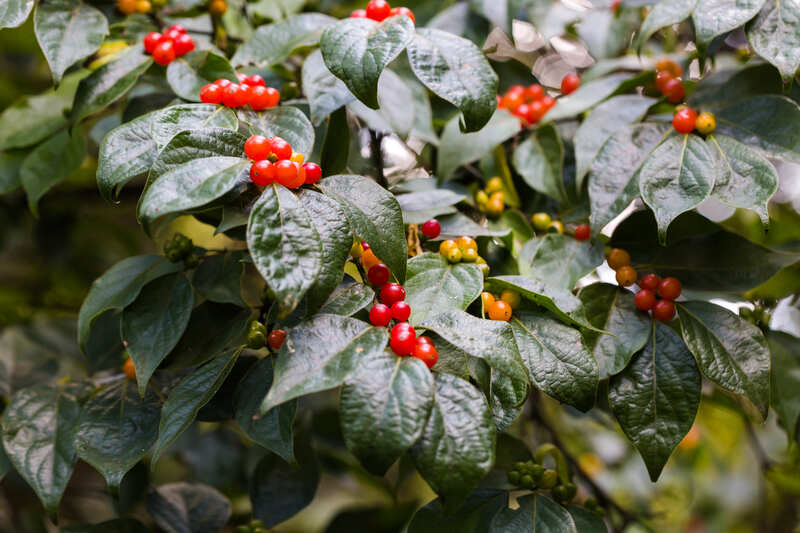
Bush honeysuckles can be one of three varieties: Amur (Lonicera maackii), Morrow (Lonicera morrowii), and Tatarian (Lonicera tatarica). They are easily spread by birds who eat their berries. Once established, they are very invasive and can dominate a landscape, crowding out native and other plants.
Life cycle: Perennial
Weed type: Shrub
Where it thrives: Shaded, woody areas with moist soils. Fields, pastures, and other open areas are also subject to invasion.
How to identify bush honeysuckles: Depending on variety, can grow from 7 feet to 30 feet tall, usually egg-shaped leaves, though Amur leaves have a sharp point. They may have pink or white tubular flowers. All produce red berries.
How to get rid of bush honeysuckle: Small honeysuckles can be pulled or dug out. An effective method is to cut the bush honeysuckle close to the ground and apply herbicide to the stump.
Common Ohio Grassy Weeds
Crabgrass (Digitaria spp.)
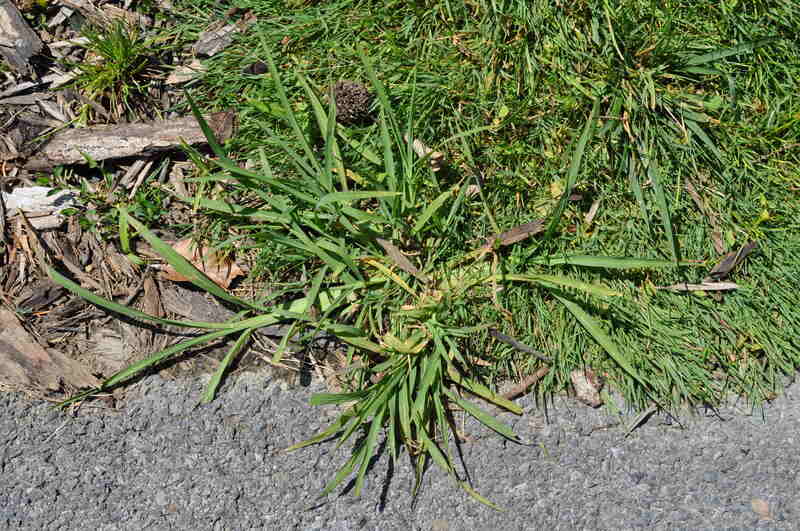
The appearance of crabgrass may be a sign that your yard needs aeration, as it prefers compacted soil. It grows in bunches and can easily take over in bare soil or in areas where the grass is thin due to heat stress. It’s best to battle crabgrass early; plants can produce up to 150,000 seeds that can lie dormant for years.
Life cycle: Summer annual
Weed type: Grass
Where it thrives: Full to partial sun, moist soil.
How to identify crabgrass: Coarse textured, yellow-green grass with spreading stems.
How to get rid of crabgrass: To manage crabgrass, use a pre-emergent herbicide. The best time to apply crabgrass preventer is between mid-March and mid-April when soil temperatures near 54 degrees. When using a post-emergent herbicide, don’t mow for two days before or after application.
Giant Foxtail (Setaria faberi)
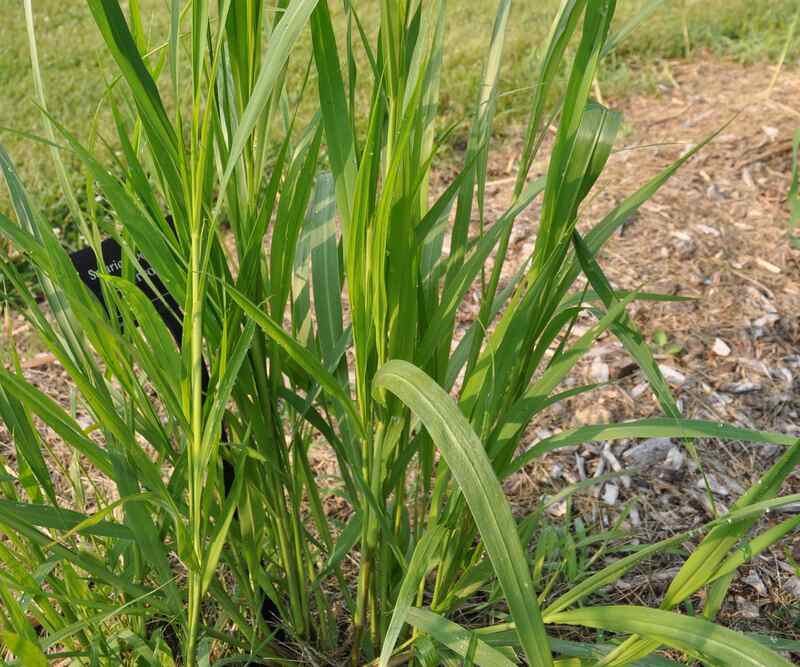
Giant foxtail is one of three species of a weed that’s common in Ohio. The others are yellow foxtail (Setaria pumila) and green foxtail (Setaria viridis). This bunch-type weed adapts to most soils and is drought-tolerant. It’s also an aggressive self-seeder and can be difficult to control once it takes hold.
Mature foxtail is dangerous to pets: According to PetMD, foxtail seeds have backward-facing barbs that burrow into skin, introducing dirt and bacteria. The barbs can be difficult to completely remove; get veterinary help, especially if they land in your pet’s eyes, ears, nose, or mouth.
Life cycle: Summer annual
Weed type: Grass
Where it thrives: Prefers sun and compacted soil with high nitrogen content
How to identify Giant foxtail: Grows up to 4 feet tall with light green, floppy leaves. It produces a 3- to 7-inch seed head that looks like a fox’s tail, and droops at maturity.
How to get rid of Giant foxtail: Use pre-emergent herbicides in early spring. You may need more than one application of post-emergent herbicide to control foxtail. Another option: Mow foxtails early in the spring before seed heads form.
Annual Bluegrass (Poa annua)
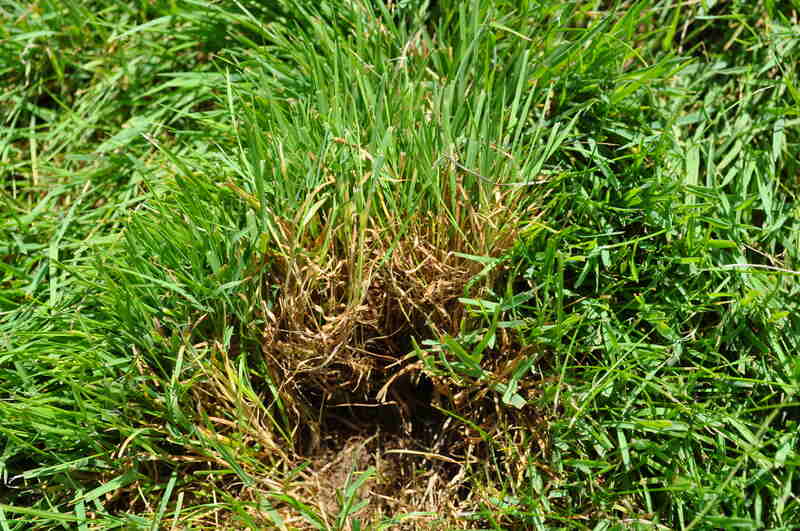
Not to be confused with Kentucky Bluegrass turfgrass (a perennial), the appearance of annual bluegrass is a signal that your lawn needs aeration. Annual bluegrass grows in tufts that are hard to control and can choke out other turfgrass. It goes dormant during summer, then seeds germinate in the fall and the grass grows through winter.
Life cycle: Cool-season annual
Weed type: Grass
Where it thrives: Shady, moist, compacted soil
How to identify annual bluegrass: Light-green leaves with a boat-shaped tip. Produces greenish-white seed heads, mostly in spring.
How to get rid of annual bluegrass: Proper lawn maintenance is the best preventative, as is aerating your yard. Small patches can be dug up. A pre-emergent herbicide can be used in the fall after the grass has gone dormant from heat.
Yellow Nutsedge (Cyperus esculentus)
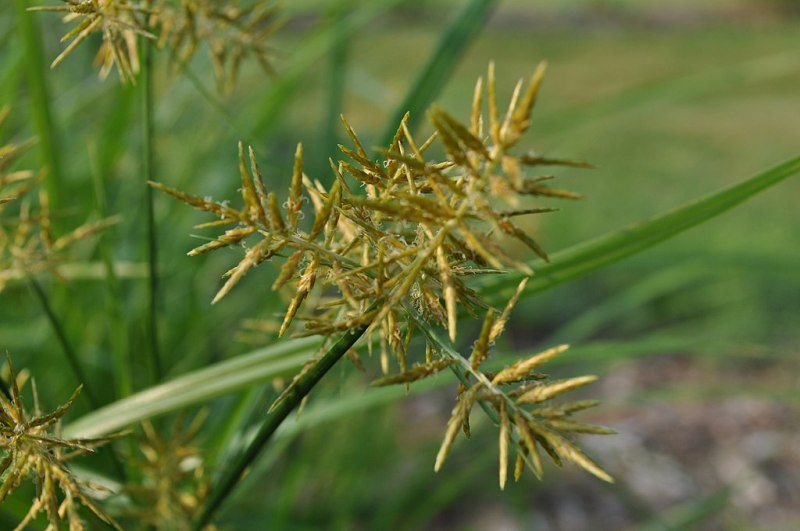
Yellow nutsedge, called one of the world’s worst weeds, can be a sign of overwatering or poor drainage, or its tubers may have arrived in a load of soil. In any case, yellow nutsedge is aggressive and difficult to control. Proper lawn maintenance will help; in gardens, consider tall, dense ground cover or shrubs that can shade it out.
Life cycle Perennial
Weed type: Grass-like, technically a sedge.
Where it thrives: Sun and moist areas.
How to identify nutsedge: Grows 12-16 inches tall, with yellowish-green leaves, triangular stem, and golden-brown flower heads.
How to get rid of nutsedge: Yellow nutsedge reproduces mainly from tubers that survive winter, making it hard to control. Young plants can be dug out, though be sure to dig 10 inches deep and 8-to-10 inches around the plants. Post-emergent herbicides can be used as spot treatments.
FAQ
First, the FDA says, immediately wash your skin with soap and cool water to remove the plant’s oil.
To calm the itching from poison ivy:
• Soak in cool water or use cool compresses.
• Use an over-the-counter topical corticosteroid. Zinc oxide or calamine lotion are other options.
• Don’t scratch. Bacteria under your nails can cause an infection.
Yes, you can eat dandelions. According to the Cleveland Clinic, dandelion greens are a great source of vitamins and minerals, among other health benefits. They can be prepared as:
• Salads
• Boiled, then sauteed with olive oil, onion, or garlic.
But don’t stop with the leaves. Also edible are:
Flowers. Use in salads or make dandelion tea or wine.
Roots. Roasted roots can be used as a coffee substitute.
Note: Be sure that you pick dandelions from an area that has not been treated with herbicides, fertilizers, or pesticides.
Tree-Of-Heaven (Ailanthus altissima) is considered a noxious weed on U.S. Forest Service land and in at least nine states. It’s designated as a “should not plant” by Ohio’s Department of Natural Resources. This non-native tree is a prolific seeder and can grow in inhospitable urban areas. Even if cut, shoots will grow rapidly.
Of greater concern, the tree-of-heaven is a primary food source for the spotted lanternfly, which was accidentally introduced to the U.S. in 2014. This insect, native to China, India, and Vietnam, has spread to several Eastern states, as well as Ohio. It attacks fruit plants, such as grapes and apples, and ornamental and woody trees.
When to Call in a Professional
Are you in need of an Ohio lawn care service near your home? We have trusted lawn care pros in Columbus, Cincinnati, Dayton, Akron, and Cleveland, plus many more cities across the Buckeye State. A local pro can help keep your yard weed-free all season long and can offer some preventative services to keep them from coming back.
Main Image Credit: klm185 / Flickr / CC BY 2.0
